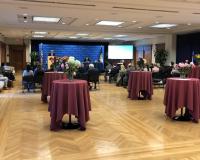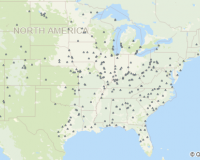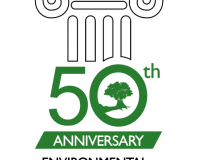
Vibrant Environment
All | Biodiversity | Climate Change and Sustainability | Environmental Justice | Governance and Rule of Law | Land Use and Natural Resources | Oceans and Coasts | Pollution Control

On the surface, the 24-Second Shot Clock, the Designated Hitter, and the Council on Environmental Quality (CEQ) NEPA regulations do not have much in common. But bear with me.
In 1954, the National Basketball Association (NBA) faced a problem—teams leading late in games would hold on to the ball, literally for minutes on end, in an effort to preserve their advantage. Ball-handling wizards like Bob Cousy could dribble out the clock, forcing the defense to chase him around in futility or commit a foul. The games got boring. NBA executives decided to install a shot clock to make their product fast-paced and exciting. The rest, as they say, is history.

On the bright, late autumn afternoon of November 19, over 100 people gathered at Georgetown University Law Center for a half-day forum on “Modernizing International Environmental Law” in celebration of Prof. Edith Brown Weiss. Co-sponsored by the Environmental Law Institute, the Georgetown Environmental Law Review, and the Georgetown Environmental Law and Policy Program, the symposium was more than a tribute to a famous scholar and beloved teacher. The presentations, panels, video calls, lively discussions, and reception portrayed a pathfinder with a strong moral compass and deep conviction—such that all of us felt inspired and motivated to continue in her footsteps.

I was raised in Illa de Arousa, an island right off the coast of Galicia, in northwestern Spain. As any kid, I would spend the summers biking around the island and swimming in the sea. My sister and I would walk around the beaches collecting seashells, looking for crabs, anemones. We would see many. We would often see schools of small squid, mackerel, arroaces (dolphins), octopuses. We used to go fishing for camarons (prawns) with my grandad.

In May 2019, Baguatan beach in the city of Tianjin, China, became a sudden and an unforeseen target of clam digging. Videos of people picking clams in Baguatan started trending on popular social media platforms, bringing further attention and more visitors to the beach. During the first half of the month, an average of 2,000 people visited the beach each day to dig for clams.

Urban areas are a significant source of pollution entering streams, lakes, and rivers because of stormwater runoff produced by impermeable surfaces such as asphalt and concrete, which prevent water from being absorbed and naturally filtered. The conventional strategy for managing urban stormwater is through gray infrastructure, such as gutters, pipes, and basins. But today, many localities are using green infrastructure, conserving or mimicking natural spaces and processes to retain and infiltrate stormwater where it is generated.

When it comes to the history of the environmental law and policy in the United States, the heroic stories most of us have heard concern men—John Muir, Aldo Leopold, Henry David Thoreau, Teddy Roosevelt, Gifford Pinchot, David Sive, David Brower, to name but a handful of the most famous. But we are less likely to know the achievements of the women who molded modern environmental policy despite having to clear hurdles seldom encountered by men.

As climate change worsens, so does the risk of wildfires. This is especially so in the western United States, as seen all too well in California in recent weeks. Adding fuel to the fire are the increasing number of homes built near areas prone to wildfires, the wildland-urban interface (WUI), which increases the risk to people and their homes, makes wildfires harder to control, and prohibits fires from being allowed to burn naturally.

Japan has been no stranger to large environmental and natural disasters over the last decade: the country has experienced several typhoons with flooding, earthquakes, heat waves, as well as the infamous Fukushima Daiichi nuclear disaster in 2011. In September, Typhoon Faxai hit Tokyo and Chiba prefecture; its strong winds and rains halted train service, damaged buildings, and took down power lines. It left three dead and dozens injured. Only a few weeks later, Typhoon Hagibis tore through the Kanto and Tohoku regions. The typhoon was so strong that three days after reaching Japan, the National Weather Service in Anchorage, Alaska, reported remnants of the typhoon had reached the other side of the Pacific.

Although it may not be a trending cocktail party topic, coal ash compliance activities are certainly well-known in the legal and environmental risk management community. Billions of dollars are at stake for the owners and operators of coal power plants impacted by the 2015 Disposal of Coal Combustion Residuals (CCR) rule.

My initial thought about this blog was to address a technical chemical regulatory topic, something like “why did it take 40 years for environmental regulators to figure out that perfluorinated compounds contaminate groundwater and don’t degrade over time?” However, this is ELI’s 50th anniversary year, and so I shall talk instead about the work I did over the course of about 15 years with ELI to address chemical regulatory and hazardous waste strategies both in the United States and abroad.